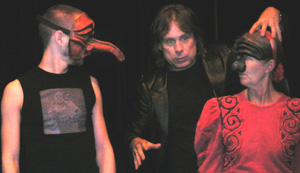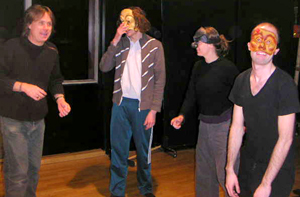While answering the questions I talked about in About mask making I was also asked about how I teach mask. Here are a little of the answer to that.
I am not bound to any specific method even though I don’t deny my background, at the Theatrestudio in Stockholm, Sweden or at Dell’Arte in Blue Lake, California. But that put together with a lot of workshops, meeting other theatre professionals that work with mask and of course my own experiences might blend into a mix that one might call a method.
I am a bit allergic to the word though since it indicates something static. I am trying to stay as open as possible and change my way of working constantly. But even so I have to admit that my teachings thru the years has somewhat formalized. Call it a method or call it a relation to the work.
So to give an example I will explain in short a sort of basic approach or structure when I teach Commedia dell’Arte (You can also see my workshop pages):
- The start is usually a lecture in Commedia dell’Arte that I scribbled down on three pages in 1993 (it can last for anything between 20 minutes up to a full day). That is not just for those who are new to Commedia dell’Arte but also a way for me to present my view on the subject.
- Then we try on the masks physically, since I see the masks as the base in Commedia
dell’Arte. I only give a very short theoretical explanation of them since the body they do – postures, movements, voice, walking patterns and so on – explains the characters of the masks much better than words. We also do some short improvisations to let the masks meet in an early phase.
To start with I am very strict with that the students or actors stay as close as they can to the given physical characters in order for them to understand the masks through their physical behavior. But as the actors start to understand the masks (both their inner and outer behavior) they are asked to individualize the masks. I see the classic movements, gestures and poses only as suggestions and a way in to the understanding of the masks. It is important that the actors put in their own body, spirit and genius instead of just filing
a mold. - The next thing we explore is the technique, both the mask technique and the technique of Commedia dell’Arte itself. We work with different exercises for size, focus, visibility, takes, relation to the audience, entrees and sorties, use of the (small) stage, to show the mask, beats, rhythm and so on. The goal is to use the technique to make the actor more alive, more precise and more expressive in the work.
I see rhythm as especially important part in all kinds of Vulgar Comedy. It is not just the timing of a gag. It is the rhythm of each mask, of the show, of every scene and so on. Here is where much of the motor to the comedy lies.
Equally important to the genre (and most Vulgar Comedy) is to train the idea of being in constant dialog with the audience. That is important in order to let the audience come in to a show and participate, not just be spectators. I see the actors more as storytellers, telling their stories as much physically as orally. They use the other masks to tell their story rather than play something on stage for the audience to watch. - Finally we throw ourselves into the crazy world of Commedia dell’Arte. We attack from two angles: the obvious is through games, play and improvisations, where we focus on flow, relations and actions. This is much of “trial and error”, working with energy and learning in the moment.
The other angle is by building lazzi, scenes, canovacci and even small scenarios, where we construct and plan scenes slowly in order to put in other disciplines like acrobatics or music.


Pingback: Commedia Erudita (part 1) | Commedia dell'Arte & Vulgar Comedy
Pingback: About teaching mask – part 2 | Commedia dell'Arte & Vulgar Comedy